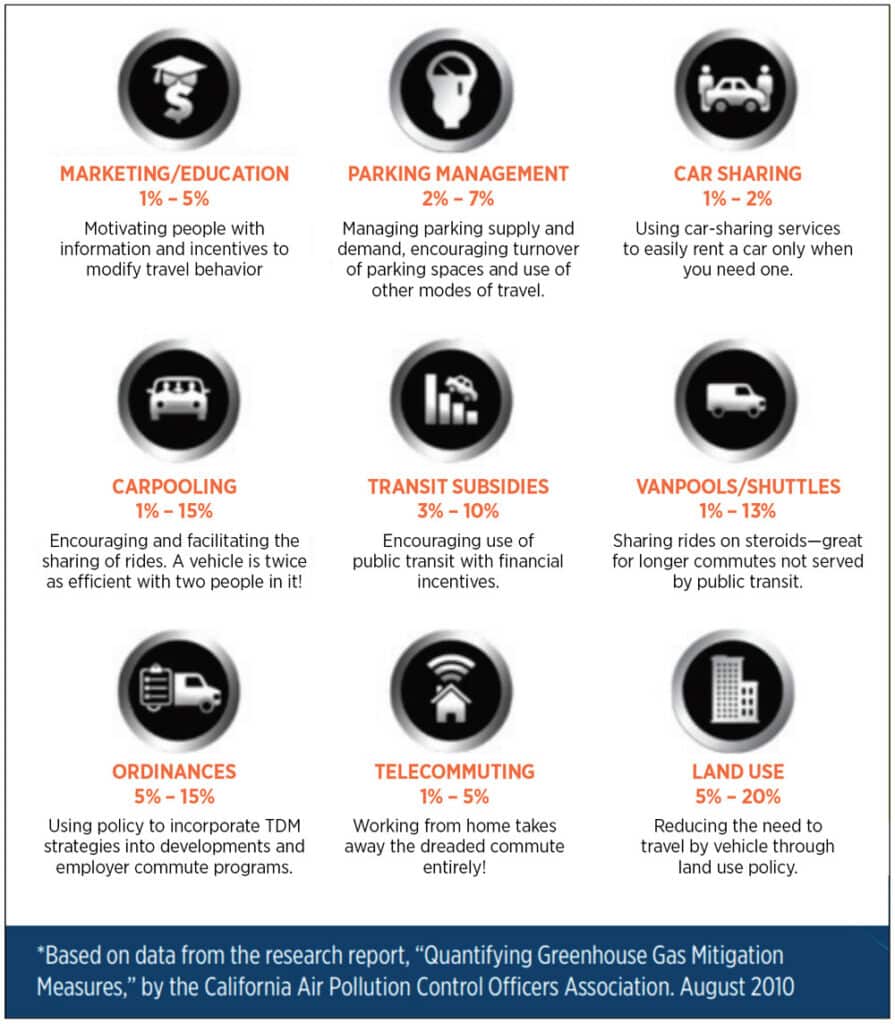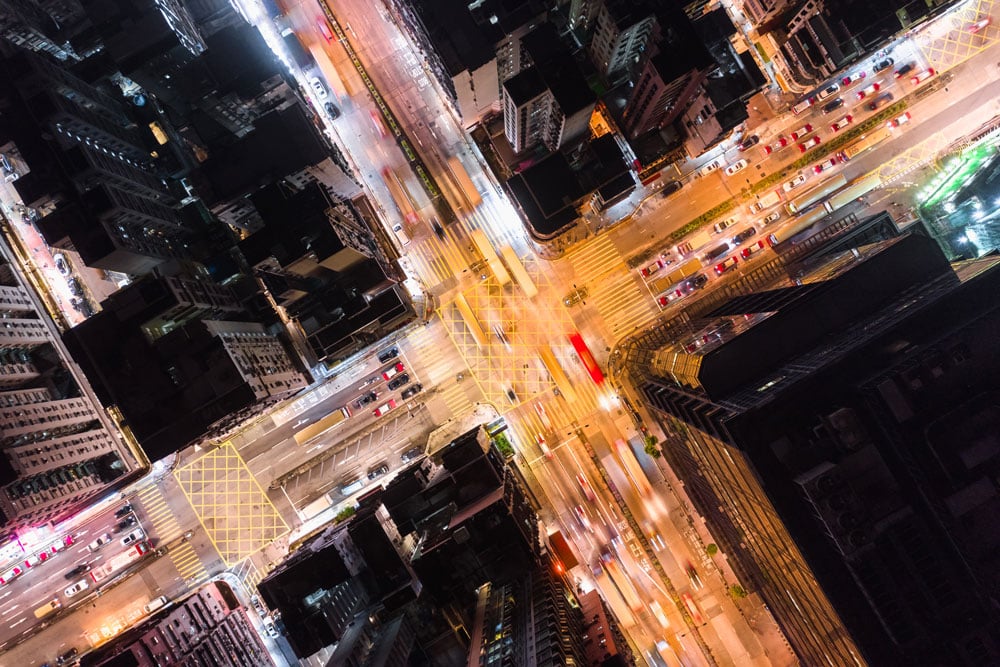TDM Collaboration Proves Two is Still Better Than One
Transportation Demand Management (TDM) is not a new concept in the transportation and mobility planning world. The concept of using incentives, disincentives, and coordinated management strategies to better balance transportation and parking demands throughout a day and within a community have been the aspiration of the planning community since we realized the significant impacts of unregulated vehicular activity. In fact, TDM was as hot a topic pre-COVID in our industry as any other recurring challenge (ahem…curb lane management…you aren’t the only challenge we face in the industry). The intention of better utilizing all mobility resources, balancing commute choices, reducing congestion, and lessening the investment in more parking and roadway capacity continue to be hot topics in municipalities and academic campuses throughout the United States.
While TDM’s importance to the health of our communities and industry isn’t new, its applications are evolving and leading to new successes. Stories of collaborative approaches to implementing TDM measures and how effective partnerships can leverage the historical tools of TDM are leading to new opportunities to completely re-define the approach to commuting and working.
In Tempe, Arizona—a market known within the parking and mobility industry as an advanced testbed of all things parking, transportation, and mobility—a specific approach to TDM is allowing that community to serve its constituents and continue to support growth without sacrificing street networks and resident and business satisfaction. The two biggest fish in the Tempe pond found that achieving TDM success was better together than alone.
The Players
Those two big fish—the City of Tempe (the City) and Arizona State University (ASU)—set the path for the downtown Tempe community. The City provides a significant amount of parking and transportation infrastructure and sets policies and practices for the success of the downtown community. ASU (also a significant provider of infrastructure) provides more than its fair share of the demand side of the equation. With more than 100,000 students, faculty, and staff on campus on normal days, the influence of ASU cannot be understated.
In 2019, ASU embarked on a planning effort to define TDM strategies on campus, with the intended goal of reducing parking and transportation demand, improving congestion, and making access to campus more efficient. ASU’s suite of services includes a robust parking system, multi-modes of transportation from bikes to feet to skateboards to scooters, and a transit system that rivals any other in the Phoenix metro area. The goal was to leverage those tools to better accommodate needs on campus without expanding parking and roadway infrastructure.
Shortly after that planning effort commenced, the City also embarked on a separate TDM planning effort to define how to accommodate the needs of the non-university community and support continued and rapid growth within the downtown community. The City has access to several multi-modal amenities including light rail, a new streetcar system, a robust biking and pedestrian network, and a centralized shared parking system managed by its partner agency, the Downtown Tempe Authority. The tools were clearly in place to reduce travel demand, improve congestion, and create a vibrant and sustainable future for the community.
As these two planning processes moved forward, the realities of TDM success clearly identified a need for collaboration and partnership between these two agencies. Any effort to reduce transportation demand on campus would need to be closely tied to the City goals and objectives (and vice versa). By forming direct partnerships and creating like-minded, parallel, and complimentary strategies, the two entities realized that their impact could be magnified, and their community supported more fully.
The Tools

With this direct approach to partnership in place, the City and ASU began to forge a realistic strategy around implementing, maintaining, and strengthening TDM strategies. Individually, singular TDM strategies aren’t specifically effective at moving the needle on congestion reduction and sustainability goals. The graphic to the right indicates that some of the highest profile TDM strategies may only have a single digit reduction on vehicle volumes. Where TDM becomes effective is the combination of strategies and incentives to promote behavioral change.
The other catalyst to achieving success in TDM programs is increasing your reach within unique groups within the community. For example, reaching commuters for office work has a specific benefit. But if you can combine that with students at the community university, you can move the needle on change even further. This collaborative approach from the City and ASU allowed for a distinct pairing of several TDM strategies targeted at a wide variety of user groups who all contributed to the transportation demands within the Tempe community.
So how are they planning to achieve their lofty TDM goals? Well, here are a few of the TDM levers the partners are currently pulling together:
- Marketing and Education: The City and ASU have a large reach within the small downtown and university footprint. Through a combination of television and radio commercials, social media outreach, and visual marketing, they are reaching an audience of commuters, business owners, patrons, residents, university visitors, students, faculty, and staff. In addition to media blitzes with targeted messaging, they also conduct events like bike month to help educate the community on the value of non-automotive travel.
- Parking Management: The two biggest parking operators in the community are the Downtown Tempe Authority (DTA) and ASU. They coordinate regularly on policy, practice, and pricing. The on-street and off-street parking systems are designed to appropriately allocate parkers based on their need and destination. Prices are set to influence commute choice on campus and within the community. In the past decade, the parking capacity of both the campus and the community has grown smaller without impacting the ability for the community to grow.
- Car Sharing and Ride Sharing: Both entities have worked collaboratively to incentivize shared ride and shared vehicle policies, dedicating space in parking facilities and on-street to promote and prioritize these uses. As the demand for these uses has ebbed and flowed due to the pandemic, the entities have worked to dial in the right amount of capacity to dedicate to shared pools to serve the demand of the community.
- Carpooling and Vanpooling: Both entities provide incentives for using pooling services, including close proximity parking, subsidies on daily parking, and shared cost permitting. The City provides a van pool composition for users within the community. And ASU provides free shuttle services throughout the Valley.
- Transit and Transit Subsidies: From the outside, the Phoenix metro area probably seems like an area that is highly car-centric, suburban, and spread out. But that is not the case in Tempe and on the ASU campus. The community is transit-rich, served by multiple light-rail stops, a new streetcar, a variety of micro-mobility options, and a downtown-specific shuttle system designed to move students, employees, and visitors alike. To incentivize the use of these tools, the City provides free transit passes to their employees and children under the age of 18. And ASU provides a 60% transit subsidy to students, faculty, and staff. Ongoing plans to create park-and-ride stations outside the downtown core to reduce vehicular demands within the community are ongoing.
- Policies and Ordinances: Both entities have recently used regulatory tools to disincentivize poor commute decisions and travel behavior. On the ASU campus, regulatory tools were designed to create multi-use paths to help move non-automotive traffic efficiently and walk-only zones to protect pedestrians and improve safety. The City used ordinances and regulatory tools to leverage micromobility tools while also managing the recent influx of single-use mobility options like scooters, e-bikes, and motorized transportation options. The City is also changing neighborhood streets ordinances to make it easier for community members to ask the City to reduce speed limits and implement traffic calming measures.
- Telecommuting: The concept of using telecommute as a strategic tool for transportation demand reduction seemed like a hurdle when both planning processes were initiated in 2019. However, that hurdle has transformed into a specific and realistic opportunity with the new approaches to work from home and hybrid working. Both ASU and the City have implemented telecommuting policies for employees (the largest pool of employees in the community) in the post-pandemic environment. These flexible policies reduce everyday traffic and help to balance demands a few days a week instead of the old five-day model. And the Downtown Tempe Authority is working with employers to ensure that flexible parking options are available and don’t subsidize the decision to drive daily.
- Land Use Decisions: One of the biggest catalysts for change in the Tempe community is the transformation of the community and the campus into a more high-density urban environment that mixes compatible uses to create a walkable, bikeable, and a less car-centric environment. The City has allowed large mixed-use projects (including housing) to be built with little to no parking, leveraging the large and centrally managed parking system run by the DTA. This incentivizes lower car usage supported by the multitude of transportation options in the community. Specific examples include the transformation of one of ASU’s largest surface parking areas into a dynamic mixed-use corridor that is intended to transform that side of campus into a new live-work-play community that energizes the community and creates more urban stability. Another example that makes national headlines is the Culdesac community that is designed to be car free and promote a non-vehicular lifestyle. Beyond these examples, the Downtown Tempe community continues to transition surface parking for higher and better uses that leverage shared parking and mobility options to grow without a “suburban-esque” parking component.
- Mobility Hubs: One of the newer additions to the TDM toolbox is the creation of central resources of transportation options that provide commuters’ options to string together commute options that solve both normal and first- and last-mile connections. These mobility hubs serve to better distribute transportation choices to reduce dependance on the single occupant vehicle trip. In Tempe alone there are several options built around light rail and transit stations, including the City of Tempe Transportation Center (adjacent to the ASU parking office) and the ASU Novus Innovation Corridor parking garage that serves campus and mixed-use needs. Tempe and ASU also provide several options like bike valets, bike cages, and micromobility options in existing parking garages.
- Transportation Management Association: The creation of entities whose mission is to help define better commute options and connect the movement of goods and people without over-reliance on single occupant vehicles are known as Transportation Management Associations or TMA’s. The City of Tempe is working to create a TMA from the ground up that will continue to include partnerships with ASU and large employers in the Downtown community.
The Outcomes
Currently, the biggest changes seen within the Tempe community are lowered parking utilizations in a post-pandemic environment. These reductions are supported by both entities approach to incentivizing telework and hybrid schedules. The community has seen as much as a 40% reduction in parking demands during some peak periods. Leveraging this unexpected benefit of the pandemic is allowing the community to further educate and promote the multitude of transportation options and helping people significantly re-think their commute choices. Recent investments in transit (bus, light rail, and streetcar) and non-automotive incentives (bike routes, shared mobility, and micromobility) are helping to transform the community’s transportation ecosystem.
By partnering and collaborating on the implementation of TDM strategies and tools within the community, ASU and Tempe aim to reduce transportation and parking demands more effectively within the Downtown community. While the process will be iterative and ongoing, the results should become apparent in early stages as commuters begin to make better choices related to how and when they access the Downtown community.
stock.adobe.com / j-mel



